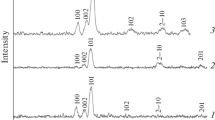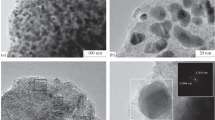Abstract
The anodic oxidation of Re metal in MeOH (Me = CH3) provides a mixture of Re2O3(OMe)6 and Re(V) oxoalkoxides that on storage or on heating give insoluble and air stable Re4O6−y (OMe)12+y (I). I can be also obtained by reaction of Re2O7 with MeOH. In the presence of MoO(OMe)4, a heterometallic complex ReMoO2(OMe)7(II) is formed as intermediate, the final product being Re4−x Mo x O6−y (OMe)12+y (III). The electrosynthesis in the presence of WO(OMe)4 gives Re4−x W x O6−y (OMe)12+y (IV) only at very high Re : W ratios in solutions and the W content varies in one and the same sample. The dissolution of Re2O7 in the solutions of MO(OMe)4, M = Mo,W in toluen on reflux yields Re4−x M x O6−y (OMe)12+y with uniform Re : M distribution. The cocrystallization of MoO(OMe)4 and WO(OMe)4 yields (Mo,W)O(OMe)4 (V) with almost uniform Mo : W distribution. The thermal decomposition of II and III in inert atmosphere gives fine powder of the (Re,Mo)O2 phase. The reduction with hydrogen gas converts II and III into an ultrafine powder of Re–Mo alloy at temperatures below 400°C. The latter can be sintered into compact metal at 800–900°C.
Similar content being viewed by others
References
J.-C. Carlen, in Rhenium and Rhenium Alloys, edited by B.D. Bryskin (TMS, Elyria, Ohio, 1997), p. 49.
M.H. Chisholm, K. Folting, J.C. Huffman, and E.M. Kober, Inorg. Chem. 24, 241 (1985).
L.G. Hubert-Pfalzgraf and J. Riess, Inorg. Chem. 14, 2854 (1975).
V.G. Kessler, G.A. Seisenbaeva, A.V. Shevelkov, and G.V. Khvorykh, J. Chem. Soc. Chem. Commun. 1995, 1779 (1995).
V.G. Kessler, A.N. Panov, N.Ya. Turova, Z.A. Starikova, A.I. Yanovsky, F.M. Dolgushin, A.P. Pisarevsky, and Yu.T. Struchkov, J. Chem. Soc. Dalton Trans. 1998, 21 (1998).
SHELXTL-NT, Reference Manual, Bruker Analytical X-Ray Instruments, Karlsruhe, 1998.
L.G. Hubert-Pfalzgraf, A. Pinkerton, and J. Riess, Inorg. Chem. 17, 663 (1978).
W. Clegg, R.J. Errington, P. Kraxner, and C. Redshaw, Inorg. Chem. 1431, 1992; V.G. Kessler, A.N. Panov, A. Yu. Borissevitch, and N.Ya.Turova, J. Sol-Gel Sci. Tech. 12, 81 (1998).
P.G. Edwards and G. Wilkinson, J. Chem. Soc., Dalton Trans. 1980, 2467 (1980).
Author information
Authors and Affiliations
Rights and permissions
About this article
Cite this article
Seisenbaeva, G., Kessler, V. & Shevelkov, A. Heterometallic Alkoxide Complexes of Variable Composition—A New Way to Ultrafine Powders of Metal Alloys. Journal of Sol-Gel Science and Technology 19, 285–288 (2000). https://doi.org/10.1023/A:1008717228528
Issue Date:
DOI: https://doi.org/10.1023/A:1008717228528




